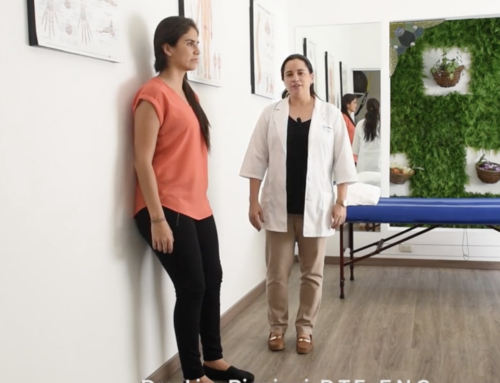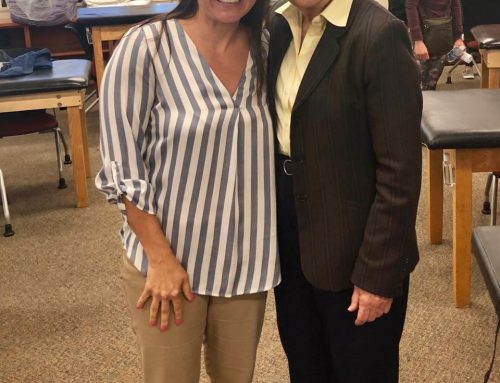Dr. Lisa Riggioni, PT, DPT speaks for the Transcranial Magnetic Stimulation Press Conference in San Jose, Costa Rica
 Dr. Lisa Riggioni, DPT, speaks in the National Press Conference on Thursday, February 11th, 2010. The main speakers for this press conference included, Dr. Andres Mesen, M.D., psychiatrist, regarding the use of Transcranial Magnetic Stimulation (TMS) and depression. While Dr. Riggioni spoke about the functional implications of TMS used with individuals who suffered a cerebrovascular accident (CVA) or stroke.
Dr. Lisa Riggioni, DPT, speaks in the National Press Conference on Thursday, February 11th, 2010. The main speakers for this press conference included, Dr. Andres Mesen, M.D., psychiatrist, regarding the use of Transcranial Magnetic Stimulation (TMS) and depression. While Dr. Riggioni spoke about the functional implications of TMS used with individuals who suffered a cerebrovascular accident (CVA) or stroke.
Transcranial magnetic stimulation is a non-invasive, therapeutic method which utilizes an electrode that transmits an electrical current directly to the optimal stimulation zone. This zone is characterized by being the zone which can produce the greatest motor-evoked potentials (MEPs) in order to stimulate the desired movement.
Treatment for patients with repercussions from a cerebral vascular accident (CVA) consists of ten TMS sessions on consecutive days. The parameters we use for repetitive transcranial magnetic stimulation (rTMS) have a low frequency of 1 Hz applied to the primary motor cortex which is unaffected or contralateral to the injury. It has been demonstrated that the hemisphere unaffected by brain injury can inhibit recuperation of the affected hemisphere. Thus, TMS stimulates the primary motor cortex of the unaffected region in order to reduce the intensity of the excitability of the uninjured cortex and free the transcallosal communication of the uninjured cortex to the injured cortex. The inhibition acts rapidly to discover existent functional connections and networks and thus contribute to cortical reorganization, motor improvement, and the isolation of desired movements.
Neurological rehabilitation, in conjunction with transcranial magnetic stimulation, is crucial in the recovery of motor function post-stroke. Treatment includes five sessions of neurological rehabilitation directed toward improving those aspects of motor functionality affected by the consequences of a cerebral vascular accident.
The procedure has distinct advantages:
- It is a non-invasive method for cerebral stimulation.
- The patient remains awake, speaking with the doctor.
- There is no need for anesthesia.
- There are no adverse effects.
- Cortical transcranial magnetic stimulation has a very low incidence of secondary effects, and these are found within the statistical range expected of a varied group of patients (Kandler; Lancet; 1990, 335, 1:469-70)
- Transcranial magnetic stimulation is a safe, efficient, clinical procedure. (Resa Jalinous, 1998)
Indications
TMS has proven to be effective in patients with consequences after suffering a cerebral vascular accident (CVA):
- It improves motor function in the paretic hand of patients who suffer slight or moderate motor deficits.
- It improves the motor function of patients with total paralysis of the affected hand.
- TMS is not time-dependent. Positive changes can be observed in the motor function of patients with recent consequences from a severe cerebral vascular accident or with chronic ones, years after the cerebral attack.
- It is very rapid, since by the seventh day, significant clinical improvement can be observed.
For more information, please visit www.tmscr.com
 Dr. Lisa Riggioni, DPT, speaks in the National Press Conference on Thursday, February 11th, 2010. The main speakers for this press conference included, Dr. Andres Mesen, M.D., psychiatrist, regarding the use of Transcranial Magnetic Stimulation (TMS) and depression. While Dr. Riggioni spoke about the functional implications of TMS used with individuals who suffered a cerebrovascular accident (CVA) or stroke.
Dr. Lisa Riggioni, DPT, speaks in the National Press Conference on Thursday, February 11th, 2010. The main speakers for this press conference included, Dr. Andres Mesen, M.D., psychiatrist, regarding the use of Transcranial Magnetic Stimulation (TMS) and depression. While Dr. Riggioni spoke about the functional implications of TMS used with individuals who suffered a cerebrovascular accident (CVA) or stroke.
Transcranial magnetic stimulation is a non-invasive, therapeutic method which utilizes an electrode that transmits an electrical current directly to the optimal stimulation zone. This zone is characterized by being the zone which can produce the greatest motor-evoked potentials (MEPs) in order to stimulate the desired movement.
Treatment for patients with repercussions from a cerebral vascular accident (CVA) consists of ten TMS sessions on consecutive days. The parameters we use for repetitive transcranial magnetic stimulation (rTMS) have a low frequency of 1 Hz applied to the primary motor cortex which is unaffected or contralateral to the injury. It has been demonstrated that the hemisphere unaffected by brain injury can inhibit recuperation of the affected hemisphere. Thus, TMS stimulates the primary motor cortex of the unaffected region in order to reduce the intensity of the excitability of the uninjured cortex and free the transcallosal communication of the uninjured cortex to the injured cortex. The inhibition acts rapidly to discover existent functional connections and networks and thus contribute to cortical reorganization, motor improvement, and the isolation of desired movements.
Neurological rehabilitation, in conjunction with transcranial magnetic stimulation, is crucial in the recovery of motor function post-stroke. Treatment includes five sessions of neurological rehabilitation directed toward improving those aspects of motor functionality affected by the consequences of a cerebral vascular accident.
The procedure has distinct advantages:
- It is a non-invasive method for cerebral stimulation.
- The patient remains awake, speaking with the doctor.
- There is no need for anesthesia.
- There are no adverse effects.
- Cortical transcranial magnetic stimulation has a very low incidence of secondary effects, and these are found within the statistical range expected of a varied group of patients (Kandler; Lancet; 1990, 335, 1:469-70)
- Transcranial magnetic stimulation is a safe, efficient, clinical procedure. (Resa Jalinous, 1998)
Indications
TMS has proven to be effective in patients with consequences after suffering a cerebral vascular accident (CVA):
- It improves motor function in the paretic hand of patients who suffer slight or moderate motor deficits.
- It improves the motor function of patients with total paralysis of the affected hand.
- TMS is not time-dependent. Positive changes can be observed in the motor function of patients with recent consequences from a severe cerebral vascular accident or with chronic ones, years after the cerebral attack.
- It is very rapid, since by the seventh day, significant clinical improvement can be observed.
For more information, please visit www.tmscr.com
Education,Neurologic,News,News & Articles,Physical Therapy Treatments,Transcranial magnetic stimulation





